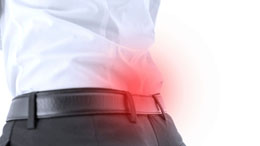Though it is not a disease, lower back pain can be either acute or chronic in its clinical presentation. This article explains the possible causes for such a problem.

Lower backache is a musculoskeletal disorder which involves the lumbar vertebrae and associated soft tissue structures, like muscles, ligaments, nerves, and the intervertebral discs. The pain can be either acute (short term), that generally lasts from a few days to a few weeks, or chronic, that persists for more than three months. The pain is often progressive, and can become severe if left untreated. It is a neurological ailment, that affects both men and women equally. Shooting or stabbing muscle pain, restricted flexibility, disability to stand straight, and numbness in the legs are some common signs of lower back pain.
Causes
Although common causes of pain in the lower back may vary from a simple injury to some severe nerve-root syndromes like sciatica, majority of the cases can be traced to one of the following severe causes.
- Muscle strain is the most common cause, which occurs due to sudden stressful injury to the lower back region, causing stretching or tearing of the muscles/tendons/ligaments.
- Lower back pain causes, due to age-related degeneration, usually occur between the ages 30 and 50. As we grow old, our bone strength, muscle elasticity, and tone, tend to reduce. This happens when the intervertebral discs start losing their fluid flexibility, also diminish their ability to cushion the vertebrae. Calcium deficiency and muscle weakening due to aging are two most common symptoms in women.
- A ruptured intervertebral disc or a herniated disc could be another cause. It usually occurs when the spinal discs degenerate or grow thinner, and bulge out of the central cavity, pushing against a nerve root.
- Spinal stenosis occurs when the intervertebral discs lose moisture and volume, and the spacing between the discs narrows. This narrowing exerts pressure on the spinal cord and nerve roots, that causes pain and numbness in the legs as well as shoulders.
- Facet joints are those at the back of each vertebra, holding the vertebra together. These enable the back to twist and bend, but if strained by a sudden jerk it can cause severe back pain.
- Cauda equina syndrome is another cause in which the disc material extends into the spinal canal, which contracts the nerves. The person may experience severe pain, loss of sensation, and bowel or bladder dysfunction.
- Scoliosis is a condition in which a person's spine curves side to side. It is an abnormal spinal development which causes occasional but severe lower backache.
- Osteoarthritis, obesity, smoking, and wrong body or sleeping postures are some of the other reasons.
Proper diagnosis is essential for the right treatment. Therefore, lower back pain caused by kidney infections, bladder infections, ovarian disorders, appendicitis, etc., should only be treated under a doctor's supervision. Sleeping with the right body posture, avoiding lifting heavy weights, keeping your back straight while standing or sitting, and regularly exercising your back and abdominal region, are some preventive measures that a person can follow. Sleeping with a pillow under the knees, keeping your back warm, taking complete bed rest for 2-4 days are some simple home remedies for lower back pain. However, if the pain is severe, one can go for medication, like Ibuprofen, Advil, Acetaminophen, Tylenol, etc., that can provide some relief.
These causes and prevention tips will surely give you a better understanding of different factors that lead to backache and the various measures to avoid them. Hence, with proper lower back exercises, a balanced diet, and body mechanics, you can keep your back trouble-free throughout life.
Disclaimer: This article is for informative purposes only and not intended to replace the advice offered by an expert on the subject.


 Lower backache is a musculoskeletal disorder which involves the lumbar vertebrae and associated soft tissue structures, like muscles, ligaments, nerves, and the intervertebral discs. The pain can be either acute (short term), that generally lasts from a few days to a few weeks, or chronic, that persists for more than three months. The pain is often progressive, and can become severe if left untreated. It is a neurological ailment, that affects both men and women equally. Shooting or stabbing muscle pain, restricted flexibility, disability to stand straight, and numbness in the legs are some common signs of lower back pain.
Lower backache is a musculoskeletal disorder which involves the lumbar vertebrae and associated soft tissue structures, like muscles, ligaments, nerves, and the intervertebral discs. The pain can be either acute (short term), that generally lasts from a few days to a few weeks, or chronic, that persists for more than three months. The pain is often progressive, and can become severe if left untreated. It is a neurological ailment, that affects both men and women equally. Shooting or stabbing muscle pain, restricted flexibility, disability to stand straight, and numbness in the legs are some common signs of lower back pain.